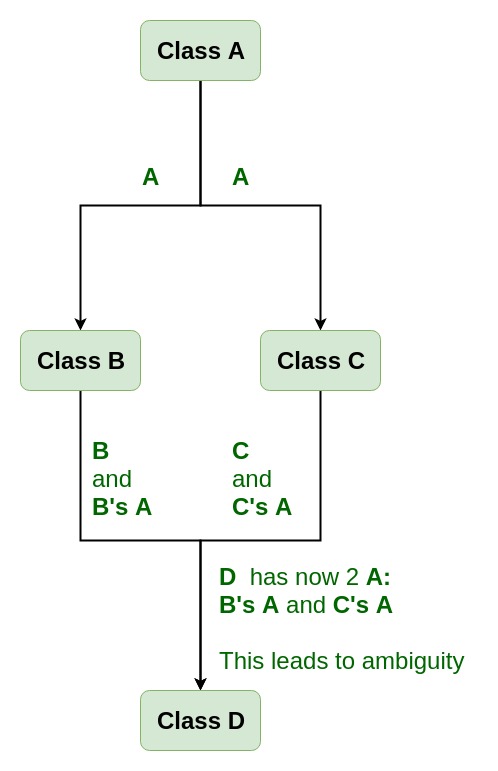Virtual base classes are used in virtual inheritance in a way of preventing multiple “instances” of a given class appearing in an inheritance hierarchy when using multiple inheritances.
Need for Virtual Base Classes:
Consider the situation where we have one class A . This class is A is inherited by two other classes B and C. Both these classes are inherited into another in a new class D as shown in figure below.

As we can see from the figure that data members/functions of class A are inherited twice to class D. One through class B and second through class C. When any data/function member of class A is accessed by an object of class D, ambiguity arises as to which data/function member would be called? One inherited through B or the other inherited through C. This confuses compiler and it displays errors.
Example: To show the need of Virtual Base Class in C++
#include <iostream>using namespace std; class A {public:void show(){cout << "Hello form A \n";}}; class B : public A {};class C : public A {}; class D : public B, public C {}; int main(){D object;object.show();} |
Compile Errors:
prog.cpp: In function 'int main()':
prog.cpp:29:9: error: request for member 'show' is ambiguous
object.show();
^
prog.cpp:8:8: note: candidates are: void A::show()
void show()
^
prog.cpp:8:8: note: void A::show()
How to resolve this issue?
To resolve this ambiguity when class A is inherited in both class B and class C, it is declared as virtual base class by placing a keyword virtual as :
Syntax for Virtual Base Classes:
Syntax 1:
class B : virtual public A
{
};
Syntax 2:
class C : public virtual A
{
};
Note: virtual can be written before or after the public. Now only one copy of data/function member will be copied to class C and class B and class A becomes the virtual base class.
Virtual base classes offer a way to save space and avoid ambiguities in class hierarchies that use multiple inheritances. When a base class is specified as a virtual base, it can act as an indirect base more than once without duplication of its data members. A single copy of its data members is shared by all the base classes that use virtual base.
Example 1
#include <iostream>using namespace std; class A {public:int a;A() // constructor{a = 10;}};class B : public virtual A {};class C : public virtual A {}; class D : public B, public C {}; int main(){D object; // object creation of class dcout << "a = " << object.a << endl;return 0;} |
Output:
a = 10
Explanation :The class A has just one data member a which is public. This class is virtually inherited in class B and class C. Now class B and class C becomes virtual base class and no duplication of data member a is done.
